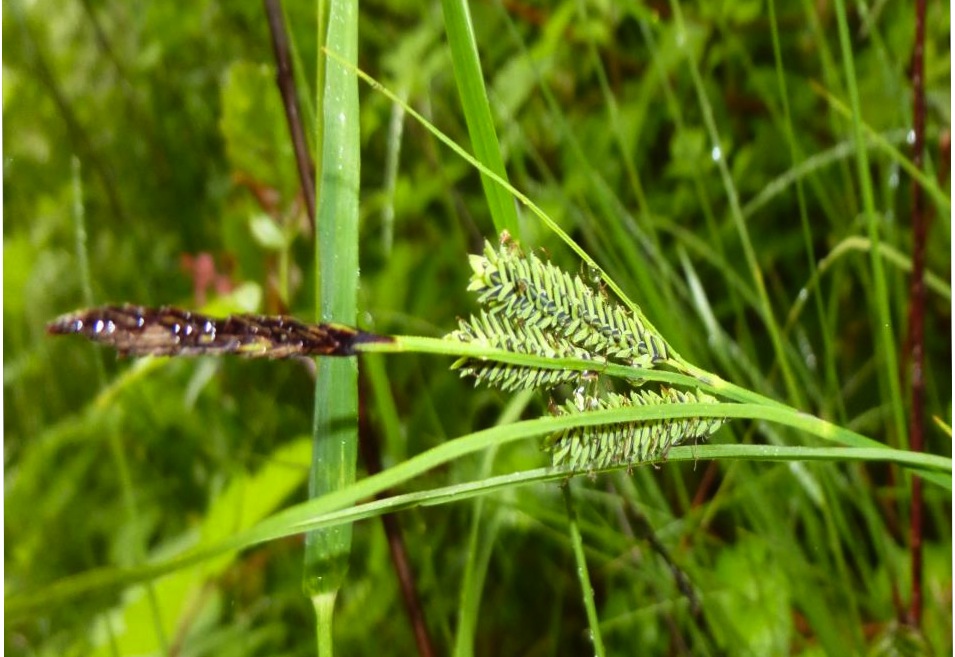Kellogg's sedge • Carex kelloggii, Carex lenticularis var. lipocarpa
{Kellogg, kelloggii = after Albert Kellogg, a 19th century physician and botanist}
Identification
Kellogg's sedge grows 10-80 cm tall from short rhizomes. Its old leaves are visible at its brownish, shredded-looking base. It grows in dense tufts, with leaves taller than the stems. Its leaves are 1-3 mm wide, and channelled underneath but flat on top. They sheath the stem, and their sheaths are spotted with brown. The terminal inflorescence is usually male. The lateral spikes are female; they tend to be closely packed, and do not droop down as in some other sedges.
Click here to see a more detailed description and some useful diagrams.
Habitat & Range
Kellogg's sedge grows in wet open areas like bogs, swamps, marshes, wet meadows, and along streams and lakes. There are four varieties of this sedge found in various parts of BC (click here to read about where the different varieties are found). This variety is found in coastal BC, and its range covers most of western North America (click here to see range map).
Similar species
The four varieties of C. lenticularis are largely differentiated by the length of the lateral spikes, the colour of the ear-shaped lobes that are found at the base of each flower bract, and the width of the basal spikes. Click here to see a key for differentiating between these species.
Intriguing Info
In some sources Kellogg's sedge is listed as its own species, C. kelloggii, and sometimes it is listed as one variety of C. lenticularis.
Kellogg's sedge grows 10-80 cm tall from short rhizomes. Its old leaves are visible at its brownish, shredded-looking base. It grows in dense tufts, with leaves taller than the stems. Its leaves are 1-3 mm wide, and channelled underneath but flat on top. They sheath the stem, and their sheaths are spotted with brown. The terminal inflorescence is usually male. The lateral spikes are female; they tend to be closely packed, and do not droop down as in some other sedges.
Click here to see a more detailed description and some useful diagrams.
Habitat & Range
Kellogg's sedge grows in wet open areas like bogs, swamps, marshes, wet meadows, and along streams and lakes. There are four varieties of this sedge found in various parts of BC (click here to read about where the different varieties are found). This variety is found in coastal BC, and its range covers most of western North America (click here to see range map).
Similar species
The four varieties of C. lenticularis are largely differentiated by the length of the lateral spikes, the colour of the ear-shaped lobes that are found at the base of each flower bract, and the width of the basal spikes. Click here to see a key for differentiating between these species.
Intriguing Info
In some sources Kellogg's sedge is listed as its own species, C. kelloggii, and sometimes it is listed as one variety of C. lenticularis.
References
Carex lenticularis Michx. In Klinkenberg, Brian. (Ed.). E-Flora BC: Electronic Atlas of the Plants of British Columbia. Lab for Advanced Spatial Analysis, Department of Geography, University of British Columbia, Vancouver. Accessed 03/09/2013.
Pojar, J. and MacKinnon, A. (1994). Plants of Coastal British Columbia. Vancouver, BC: Lone Pine Publishing. P. 398.
Carex lenticularis Michx. var. lipocarpa (T. Holm) L.A. Standl. Plants Database. USDA National Resources Conservation Service. Accessed 03/09/2013.
Authors and editors of page
Kelly Fretwell and Brian Starzomski (2013).
Carex lenticularis Michx. In Klinkenberg, Brian. (Ed.). E-Flora BC: Electronic Atlas of the Plants of British Columbia. Lab for Advanced Spatial Analysis, Department of Geography, University of British Columbia, Vancouver. Accessed 03/09/2013.
Pojar, J. and MacKinnon, A. (1994). Plants of Coastal British Columbia. Vancouver, BC: Lone Pine Publishing. P. 398.
Carex lenticularis Michx. var. lipocarpa (T. Holm) L.A. Standl. Plants Database. USDA National Resources Conservation Service. Accessed 03/09/2013.
Authors and editors of page
Kelly Fretwell and Brian Starzomski (2013).




